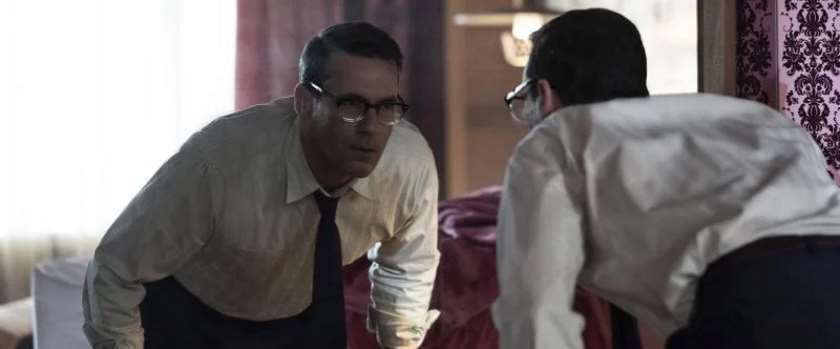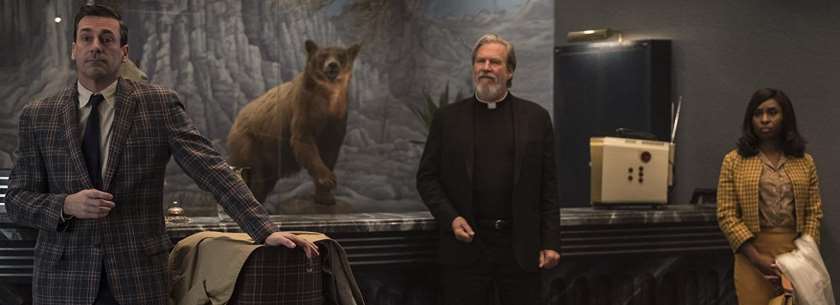Bad Times at the El Royale
A strange game. The only winning move is not to play.
The El Royale hotel sits smack dab on the divide between California and Nevada. On the side of California is a bar stocked with liquor and alcohol while on the other side gambling machines reside. An establishment built upon a gimmick of each state’s advantages and disadvantages, all reliant upon which side of the border you happen to be on at that very moment.
It’s also a very blunt signal to the viewer that this film is about to explore some form of duality.
The film begs another question, however: just how significant is the difference between these two sides? How fine is the line? Or is it all just a game?
I should warn that I can only give a surface level reading of these concepts. I’ve only seen the film once in theaters and plan to more thoroughly explore it with subsequent viewings when it releases on Blu-Ray. Nevertheless, consider this write-up to be a first impression rather than a thorough analysis. A voicing of theories as opposed to firm arguments.
The duality in question is in regard to not just the characters, but to the hotel itself. A single viewing of the trailer will reveal the El Royale’s hidden passages dedicated to observing its guests. A dark and seedy violation of privacy that triggers paranoia among its guests.
As we swiftly begin to discover, each guest is not what they seem. While there’s the obvious shadowy persona concealed by a friendly face, there’s also the more honest heart masquerading as a suspicious personality. The only thing for certain is that the exterior conceals the far more complex interior.
This observation of each person having two sides of themselves isn’t necessarily the point. Instead, the film seems to assert that having two selves is an expectation. The playing of some grand game of society where participants are forced to “choose a side”, with each individual trying to bury their “bad” vices or unwelcome traits while putting forward a “good” face.

Some characters are better at this than others, but the film makes it clear that not everyone fits so easily into society’s game. Women, African Americans, ex-convicts and war veterans are all unable to fit into the greater culture’s definitions of suitability. It’s no surprise that the man most feared is a white male insistent that he sees through society’s lies, yet is obsessed with forcing others to play his game.
Which is where I find the film most fascinating. Not necessarily in any assertions regarding culture, but how it uses these characters struggling with society to shift our allegiances.
Allow me to take a moment to digress away from the film’s themes and instead into my fascination and growing fandom of writer and director Drew Goddard. He had gotten his start working with Joss Whedon and J.J. Abrams on their respective television shows of Buffy the Vampire Slayer, Angel, Alias, and Lost. He has somehow managed to capture the best of each camp without falling victim to their worst traits.
Like Whedon and Abrams, Goddard enjoys his surprises. However, in Bad Times especially, these surprises lack the inflated ego of Whedon’s self-assured cleverness while also having greater purpose than Abrams’ reliance upon “and then THIS happened”. The characters are fully realized before the story takes place. The story is simply written so that the truth of these characters is revealed in a manner that causes shock to the viewer.
Yet upon a second viewing we see that this is who that character was the whole time. While Cabin in the Woods certainly has more than enough of Whedon’s sense of humor and loathing for authority, there’s still a respect for humanity that makes each character somehow relatable. Even the bad guys are a crowd favorite! While Joss Whedon would have a clear idea of who the bad guy is, Drew Goddard brings in a respectful heart that drives the audience to root for both sides at different times. We understand the motivations of the “villain” even if we don’t like the method.

Bad Times at the El Royale has more than a few similarities with Cabin in the Woods in this way, but it also allows Goddard to write a story that is wholly his. Humorously enough, it turns out a story that is wholly his also feels like a Quentin Tarantino film, only with a bit less blood and complete absence of the heinous N-Word.
While Goddard lacks the same stylistic and eccentric flairs of Tarantino, his film is no doubt still a gateway to his own philosophies and values. Goddard developed a series of twists and expectations to keep the film compelling, but what makes Bad Times at the El Royale a true fascination is how the audience may be driven to crave a character’s death at the film’s midpoint, then shocked and upset when said character finally bites the dust towards the climax.
It causes me to wonder if Goddard is bringing the audience into a game of his own, or if he is encouraging the audience to question their preconceived notions of good and bad.
Sadly while writing this piece I found an article that pretty clearly outlines Drew Goddard’s motivations. On the one hand it’s good to know that I was pretty much on the right track with my reading of the film.
On the other, it feels as if I have too many definitive answers to some of my questions. I can only instead consider it an irony that the film itself has an unintended meta-theme, where the audience’s perception of good and bad is manipulated by a white man at the keyboard and behind the camera.
I suppose that’s just the reality of entertainment, however. I don’t think Goddard is trying to pull a Levine on us, basking in a stoner’s glow and having our minds blown by a film’s role as audience manipulator. It certainly is a potential read of the work and the context in which it was created, though.
Regardless of where your personal politics takes you, I do believe Bad Times at the El Royale has a respect for humanity and the desire to be good. It does not celebrate the misfit in the same manner that, say, Tim Burton would, and it does not dehumanize the figures it seeks to criticize.
It instead suggests that society’s insistence on two sides is, perhaps, little more than a gimmick and illusion.


